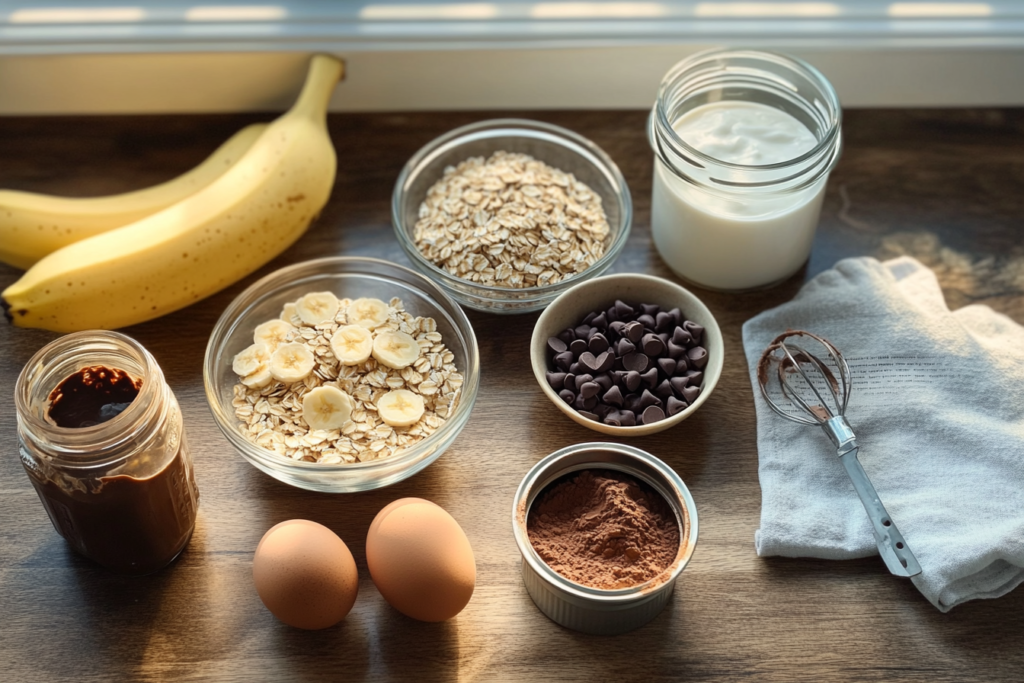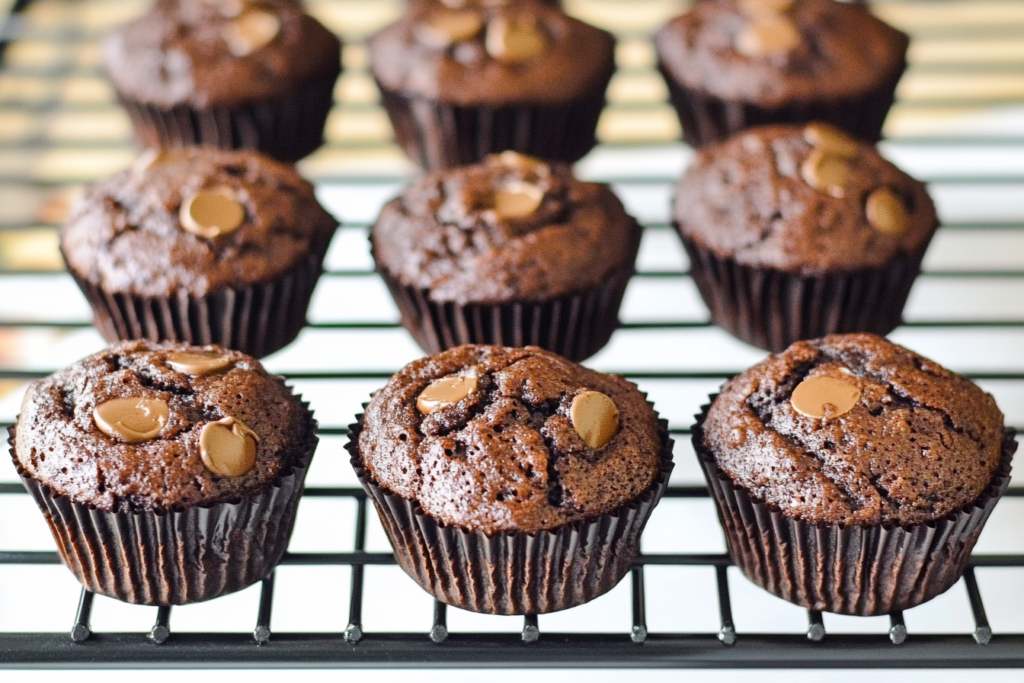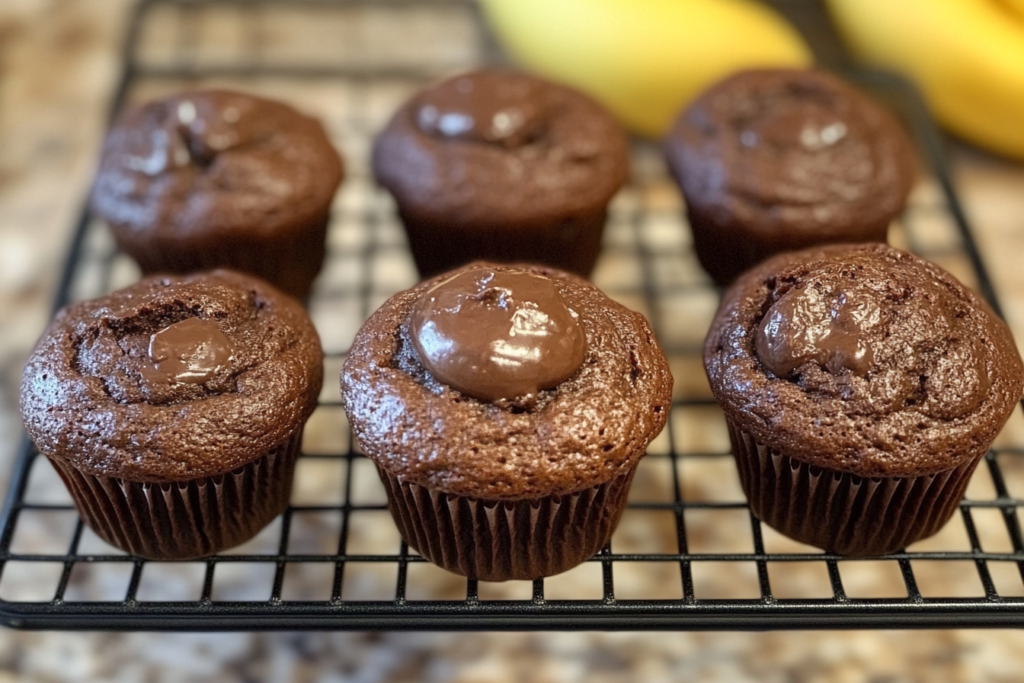If you’re always on the go and trying to find that sweet spot between healthy eating and indulging your chocolate cravings, chocolate protein muffins could be exactly what you’ve been missing. These rich, moist, and nutrient-dense muffins aren’t just another breakfast trend—they’re a practical solution to your busy mornings, afternoon hunger pangs, or post-workout energy dips.
You might remember mornings when grabbing a sugar-loaded pastry felt like your only option. Or maybe you’ve skipped breakfast entirely, hoping coffee would be enough to carry you through until lunch. The result? Energy crashes, cravings, and regret. That’s where chocolate protein muffins step in. They offer the familiar comfort of chocolate with the added bonus of keeping you full and fueled.
Let’s dive into how you can bring these nutritious treats into your routine, without sacrificing taste or time.
Table of Contents
What Are Chocolate Protein Muffins?
Chocolate protein muffins are exactly what they sound like—muffins made with protein-packed ingredients and flavored with rich cocoa or chocolate. But they’re more than just a healthier muffin. They’re a functional snack or meal component that supports your lifestyle goals, whether you’re aiming to build muscle, manage weight, or simply stay energized throughout the day.
These muffins typically combine whole grains like oats or almond flour, protein powders, Greek yogurt, and natural sweeteners. The result? A soft, chocolatey texture with a powerful nutrition profile.
Unlike traditional bakery muffins, which are often loaded with empty carbs and refined sugars, chocolate protein muffins are formulated to give your body something it can actually use. They’re not just less unhealthy—they’re truly good for you.
Why They Stand Out:
- High in protein (10–15g per muffin on average)
- Lower in sugar and calories
- Easy to customize for dietary needs
- Quick to make and meal-prep friendly
When you make them at home, you control everything that goes into them, from the type of protein powder to the level of sweetness and added extras.
Easy and Healthy Chocolate Protein Muffins Recipe
You don’t need to be a pro in the kitchen to whip up these muffins. The recipe below is both beginner-friendly and adaptable, making it perfect for busy weekdays or your Sunday meal prep routine.

Ingredients
| Ingredient | Amount |
|---|---|
| Rolled oats or oat flour | 1 cup |
| Chocolate protein powder | 1 scoop (~30g) |
| Unsweetened cocoa powder | 2 tablespoons |
| Baking powder | 1 teaspoon |
| Salt | 1/4 teaspoon |
| Ripe banana or applesauce | 1/2 cup |
| Greek yogurt | 1/2 cup |
| Egg | 1 |
| Maple syrup or honey | 2 tablespoons |
| Milk (any variety) | 1/2 cup |
| Dark chocolate chips | 1/4 cup (optional) |
Instructions
- Set your oven to 350°F and prepare a muffin tin by either lining it with paper cups or lightly coating it with oil or nonstick spray.
- Mix all dry ingredients in a bowl: oats, protein powder, cocoa powder, baking powder, and salt.
- In a separate bowl, whisk together wet ingredients: mashed banana or applesauce, yogurt, egg, sweetener, and milk.
- Combine wet and dry mixtures, stirring gently. Don’t overmix.
- Fold in chocolate chips if using, then spoon the batter into the muffin cups, filling them about 3/4 full.
- “Place in the oven and bake for 18 to 22 minutes, or until a toothpick inserted in the center comes out clean or with just a few moist crumbs.
- Allow the muffins to cool in the pan for 5 minutes, then transfer to a wire rack to cool completely.
These muffins stay fresh in the refrigerator for up to five days and can be frozen for longer storage, making them ideal for batch prepping.
Why Chocolate Protein Muffins Are a Healthier Choice
It’s easy to assume that anything with “muffin” in the name must be a treat. But when made with clean ingredients and smart substitutions, these muffins become a smart addition to your eating plan.
Here’s how they benefit your body:
- Protein for satiety and muscle repair: You stay full longer and support lean muscle mass.
- Slow-digesting carbs: Rolled oats or whole grain flours offer steady energy.
- Less sugar crash: Natural sweeteners and lower glycemic ingredients keep blood sugar stable.
- Great for active lifestyles: They fit easily into post-gym snacks or meal-prep strategies.
Let’s compare them side-by-side with a traditional muffin:
| Type | Calories | Protein | Sugar |
|---|---|---|---|
| Bakery chocolate muffin | ~400 | ~4g | ~30g |
| Homemade protein muffin | ~200 | ~12g | ~8g |
You can see the difference—especially in protein and sugar content. It’s not just about eating fewer calories, but about getting more from every bite.
How to Customize Chocolate Protein Muffins to Match Your Goals

One of the greatest advantages of making chocolate protein muffins at home is how easily you can adapt them to your preferences or dietary needs. Whether you’re avoiding dairy, reducing carbs, or following a plant-based lifestyle, there’s a variation that fits.
Make It Yours with These Smart Substitutions
- For dairy-free muffins: Swap Greek yogurt with a plant-based version like coconut or almond yogurt, and use almond milk instead of dairy milk.
- For an egg-free option, substitute each egg with a flaxseed mixture by combining 1 tablespoon of ground flaxseed with 3 tablespoons of water to act as a binder.
- To lower carbs: Replace oats with almond flour or a low-carb baking mix.
- For a vegan version: Use a plant-based protein powder and ensure your chocolate chips are dairy-free.
You can also adjust the sweetness depending on your needs. Try monk fruit sweetener or stevia for a sugar-free version, or use mashed banana for natural sugars and added moisture.
Add-Ins That Boost Flavor and Nutrition
Want more texture or nutritional value in your muffins? Consider stirring in:
- Chia seeds or hemp hearts
- Shredded zucchini or carrots
- Chopped nuts like walnuts or almonds
- Berries for a fruity twist
These ingredients not only make the muffins more exciting but also increase fiber, healthy fats, and antioxidants—without adding empty calories.
Choosing the Best Protein Powder for Baking
Protein powders vary in how they perform during baking. Some can leave a chalky texture, while others blend seamlessly into your batter.
What to Look For:
- Whey Protein Isolate: Great texture and mild taste, ideal for muffins.
- Casein Protein: Absorbs more liquid, producing a denser muffin—perfect if you like a rich texture.
- Plant-Based Proteins: Pea, rice, or hemp protein work well but may require additional moisture.
Avoid flavored powders with artificial sweeteners if you’re sensitive to taste. Also, always test a small batch when using a new protein to gauge how it behaves in your recipe.
Trusted Recipes to Explore and Compare
If you’re eager to explore more variations or troubleshoot your own baking process, there are some excellent high-protein muffin recipes available online that offer a solid foundation and inspiration.
For instance, Eating Bird Food’s Chocolate Protein Muffins are a fantastic option if you’re aiming for clean, whole-food ingredients. The recipe uses oat flour and banana for natural sweetness and makes use of chocolate protein powder to hit your nutrition goals while keeping the texture light and fluffy.
You can also check out Featherstone Nutrition’s High Protein Chocolate Blender Muffins which are designed for performance-focused eaters. These blender-friendly muffins come together quickly, using simple pantry ingredients and emphasizing fuel for active days.
For more protein-packed muffin ideas, check out these delicious Chocolate Protein Muffins from My Recipes Era. They’re the perfect treat for anyone looking to boost their protein intake while enjoying a sweet snack!
Exploring these recipes not only gives you ideas but also shows how easy it is to tweak ratios, ingredients, or flavors without sacrificing your goals.
Storage, Freezing, and Meal Prep Tips

You don’t need to bake daily to enjoy these muffins fresh. With a few smart storage tricks, you can always have a protein-packed snack ready when you need it.
How to Store:
- Keep at room temperature in an airtight container for up to 2 days.
- In the refrigerator: Keep in a sealed container for up to 5 days.
- In the freezer: Wrap each muffin individually and place in a ziplock bag. They’ll stay fresh for up to 3 months.
Reheating Tips:
- Microwave for 20–30 seconds to bring back that just-baked warmth.
- Add a dab of nut butter on top for a satisfying protein and fat boost.
Prepping a dozen muffins in advance means you can fuel your mornings or satisfy cravings without reaching for empty-calorie snacks. It’s one of the easiest ways to stay on track, especially if you’re juggling work, fitness, and family life.
Frequently Asked Questions About Chocolate Protein Muffins
Are chocolate protein muffins actually healthy?
Yes, when made with clean ingredients, chocolate protein muffins can be a smart addition to your routine. They offer a balanced combination of protein, fiber, and healthy fats, especially when you skip refined sugar and white flour. Just be mindful of the total calorie count and protein quality, especially if you’re aiming for specific fitness goals.
Can I use any kind of protein powder in muffins?
Technically, yes—but the texture and flavor will vary depending on the type. Whey protein blends well, while plant-based proteins may require more liquid. Always test small batches first, and adjust sweeteners or fats to achieve the right consistency.
How do I stop my muffins from becoming dry?
Protein powder tends to absorb moisture, so always include a wet ingredient like banana, applesauce, yogurt, or milk. Don’t overmix the batter, and keep an eye on your baking time. Slightly underbaking by a minute or two helps retain moisture without compromising structure.
What’s the best time to eat these muffins?
You can enjoy them any time—post-workout for recovery, at breakfast for a high-protein start, or as a mid-day snack. Thanks to the balanced macronutrients, they keep you fuller longer and curb sweet cravings more effectively than traditional baked goods.
Busting Common Myths About Protein Muffins
You might hear conflicting advice when it comes to baking with protein. Here’s what you need to know:
Myth 1: Protein muffins can’t taste good.
That’s simply not true. When made correctly, protein muffins can be just as delicious and moist as their sugary counterparts. Flavorful ingredients like cocoa powder, nut butters, and mashed fruit enhance the taste without unnecessary sugar.
Myth 2: You need a high-end blender or fancy equipment.
Not at all. While some recipes use blenders for speed, you can mix most protein muffin batters by hand with basic kitchen tools. The secret lies in ingredient ratios and mixing technique, not expensive appliances.
Myth 3: You have to eat them right away.
Wrong again. These muffins store beautifully, freeze well, and are perfect for meal prep. You can bake a dozen on Sunday and have ready-to-go snacks or mini meals all week.
Your Next Muffin Adventure Starts Now
There’s a reason why chocolate protein muffins are more than a trend—they fill the gap between indulgence and nourishment. Whether you’re managing macros, building muscle, or just trying to cut back on sugar, they offer a guilt-free way to enjoy chocolate without sacrificing your goals.
You now know how to select the best protein powder, tweak recipes to your needs, and avoid the pitfalls that lead to dry or bland muffins. The next step? Head to your kitchen and bake a batch tailored just for you.
Experiment. Taste. Adjust. And don’t be afraid to make it your own. The freedom to customize and the ability to fuel your body with intention is what makes chocolate protein muffins such a rewarding baking project.

